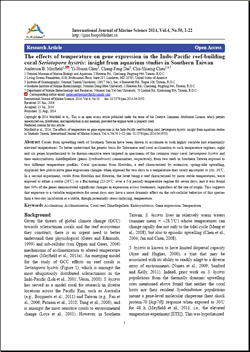The effects of temperature on gene expression in the Indo-Pacific reef-building coral Seriatopora hystrix: insight from aquarium studies in Southern Taiwan
(2014)
Please find an excerpt of the full PDF below
This article, published by one of the Living Oceans Foundation Fellows, Andersen Mayfield, PhD, delivers insight acquired from aquarium studies in Southern Taiwan into the effects of temperature on gene expression in the Indo-Pacific reef-building coral Seriatopora hystrix.
The effects of temperature on gene expression in the Indo-Pacific reef-building coral Seriatopora hystrix: insight from aquarium studies in Southern Taiwan
International Journal of Marine Science
July 13, 2014
By Anderson B. Mayfield, Yi-Hsuan Chen, Chang-Feng Dai, Chii-Shiarng Chen
 Corals from upwelling reefs of Southern Taiwan have been shown to acclimate to both highly variable and abnormally elevated temperatures. To better understand the genetic basis for Taiwanese reef coral acclimation to such temperature regimes, eight and six genes hypothesized to be thermo-sensitive were targeted in specimens of the common stony coral Seriatopora hystrix and their endosymbiotic dinoflagellate (genus Symbiodinium) communities, respectively, from two reefs in Southern Taiwan exposed to two different temperature profiles. Coral specimens from Houbihu, a reef characterized by extensive, spring-tide upwelling, displayed few provocative gene expression changes when exposed for two days to a temperature they rarely encounter in situ, 30℃. In a second experiment, corals from Houbihu and Houwan, the latter being a reef characterized by more stable temperatures, were exposed to either a stable (26℃) or a fluctuating (23-29℃ over a 5-h period) temperature regime for seven days, and it was found that 50% of the genes demonstrated significant changes in expression across treatments, regardless of the site of origin. This suggests that exposure to a variable temperature for seven days may have a more dramatic effect on the sub-cellular behavior of this species than a two-day incubation at a stable, though potentially stress-inducing, temperature.
Corals from upwelling reefs of Southern Taiwan have been shown to acclimate to both highly variable and abnormally elevated temperatures. To better understand the genetic basis for Taiwanese reef coral acclimation to such temperature regimes, eight and six genes hypothesized to be thermo-sensitive were targeted in specimens of the common stony coral Seriatopora hystrix and their endosymbiotic dinoflagellate (genus Symbiodinium) communities, respectively, from two reefs in Southern Taiwan exposed to two different temperature profiles. Coral specimens from Houbihu, a reef characterized by extensive, spring-tide upwelling, displayed few provocative gene expression changes when exposed for two days to a temperature they rarely encounter in situ, 30℃. In a second experiment, corals from Houbihu and Houwan, the latter being a reef characterized by more stable temperatures, were exposed to either a stable (26℃) or a fluctuating (23-29℃ over a 5-h period) temperature regime for seven days, and it was found that 50% of the genes demonstrated significant changes in expression across treatments, regardless of the site of origin. This suggests that exposure to a variable temperature for seven days may have a more dramatic effect on the sub-cellular behavior of this species than a two-day incubation at a stable, though potentially stress-inducing, temperature.
